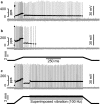Complex impairment of IA muscle proprioceptors following traumatic or neurotoxic injury
- PMID: 26047324
- PMCID: PMC4523324
- DOI: 10.1111/joa.12312
Complex impairment of IA muscle proprioceptors following traumatic or neurotoxic injury
Abstract
The health of primary sensory afferents supplying muscle has to be a first consideration in assessing deficits in proprioception and related motor functions. Here we discuss the role of a particular proprioceptor, the IA muscle spindle proprioceptor in causing movement disorders in response to either regeneration of a sectioned peripheral nerve or damage from neurotoxic chemotherapy. For each condition, there is a single preferred and widely repeated explanation for disability of movements associated with proprioceptive function. We present a mix of published and preliminary findings from our laboratory, largely from in vivo electrophysiological study of treated rats to demonstrate newly discovered IA afferent defects that seem likely to make important contributions to movement disorders. First, we argue that reconnection of regenerated IA afferents with inappropriate targets, although often repeated as the reason for lost stretch-reflex contraction, is not a complete explanation. We present evidence that despite successful recovery of stretch-evoked sensory signaling, peripherally regenerated IA afferents retract synapses made with motoneurons in the spinal cord. Second, we point to evidence that movement disability suffered by human subjects months after discontinuation of oxaliplatin (OX) chemotherapy for some is not accompanied by peripheral neuropathy, which is the acknowledged primary cause of disability. Our studies of OX-treated rats suggest a novel additional explanation in showing the loss of sustained repetitive firing of IA afferents during static muscle stretch. Newly extended investigation reproduces this effect in normal rats with drugs that block Na(+) channels apparently involved in encoding static IA afferent firing. Overall, these findings highlight multiplicity in IA afferent deficits that must be taken into account in understanding proprioceptive disability, and that present new avenues and possible advantages for developing effective treatment. Extending the study of IA afferent deficits yielded the additional benefit of elucidating normal processes in IA afferent mechanosensory function.
Keywords: chemotherapy; mechanotransduction; muscle spindle; sensory encoding; synaptic transmission.
© 2015 Anatomical Society.
Figures






References
-
- Abelew TA, Miller MD, Cope TC, et al. Local loss of proprioception results in disruption of interjoint coordination during locomotion in the cat. J Neurophysiol. 2000;84:2709–2714. - PubMed
-
- Andre T, Boni C, Navarro M, et al. Improved overall survival with oxaliplatin, fluorouracil, and leucovorin as adjuvant treatment in stage II or III colon cancer in the MOSAIC trial. J Clin Oncol. 2009;27:3109–3116. - PubMed
-
- Argyriou AA, Polychronopoulos P, Iconomou G, et al. A review on oxaliplatin-induced peripheral nerve damage. Cancer Treat Rev. 2008;34:368–377. - PubMed
Publication types
MeSH terms
Substances
Grants and funding
LinkOut - more resources
Full Text Sources
Other Literature Sources
Medical

